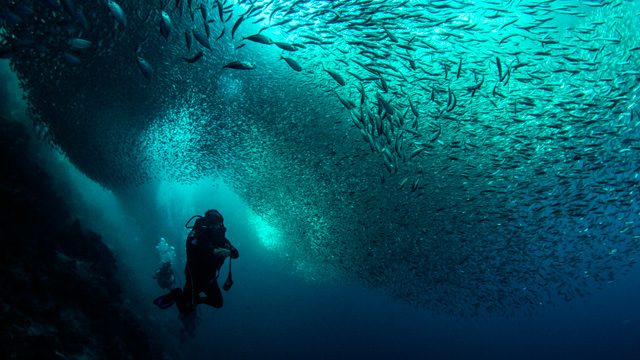SUMMARY
This is AI generated summarization, which may have errors. For context, always refer to the full article.

Flying above the country last month, I gazed at an endless expanse of ocean, deep cobalt dotted by turquoise reefs and marred only by ochre plumes discharged by rivers.
From our plane, the puffy cumulous clouds we were avoiding – everything was dwarfed by the big blue.
I’ve spent a fair amount of time in it – visiting coral reefs, seagrass beds and mangrove stands as part of environmental group WWF. I know little, but I know our oceans mean a lot.
Now I’ve joined Oceana, an international organization fighting to keep seas as productive as they once were.
Overfishing is the main issue, with today’s fishers ranging farther and trying harder to catch more – but there are too many fishers and too few fish. The global fishing fleet is estimated to be 250% bigger than it should be to keep fisheries sustainable. Whole schools are scooped up before they reproduce, leaving fewer fish each cycle.
“Due to overfishing, scientific reports have shown that we are catching less than we have in the past. The global catch hit peak fish in 1996 and has declined ever since,” warns Oceana CEO Andrew Sharpless.
Mouths to feed
What’s tougher than feeding a billion people? Feeding 9 billion.
Many of the 7 billion people today (including you hopefully) will share the world with another two billion by 2050. Theoretically, it’s a simple equation: we must produce enough food to feed everyone three squares daily.
The problem is that 925 million or about one in 7 mouths are already going to bed hungry tonight. The natural systems we rely on for food are assailed by overuse, pollution and climate change.

Take farming, humanity’s main food generator. It requires water, fertilizer and farmland – something we’re running out of unless we cut down our remaining forests. It is also a major driver of climate change – emitting more greenhouse gases than all the world’s cars, trains and aircraft combined.
Aquaculture is a solution, but still requires copious amounts of feeds and can introduce ravenous invasive species like tilapia and golden kuhol which can wipe out native aquatic life.
So which food production system requires no fresh water, fertilizer or farmland?
Blue food factory
From the plane, I gazed down at the ocean. And I knew.
That oceans can turn sunlight and nutrients into plankton, fueling the creation of vast shoals of fish. Enough to feed ocean giants like tuna, sharks, and whales. Enough to feed you and me with leftovers aplenty.
“Wild fish are the world’s most cost-efficient protein source. They are renewable, low-carbon and much cheaper to produce than chicken, pork or beef,” explains Oceana Philippines head, lawyer Gloria Estenzo Ramos.
Oceana was created from the realization that the big blue produces food for free – and that 25 nations produce 90% of the world’s seafood. “If we can reduce overfishing, prevent bycatch and protect vital marine habitats in these 25 countries, then we can rebuild the world’s fish stocks,” added Ramos.
By protecting fisheries with science-based policies and empowering coastal communities to defend their home waters, humanity can raise yearly wild seafood yields by 100 million metric tonnes – enough to feed a billion people every day, forever.
I’ve already seen this work in the Tubbataha Reefs, where strong leadership from the public and private sector doubled fish biomass in just a few years. There, clouds of fish pulsate over sprawls of coral and sponge.
Oceana’s famed battle-cry, a clarion-call for good fisheries governance, is now heard in boardrooms, fishing villages and other hubs in a hundred nations: save the oceans, feed the world.
So this is how we can feed a billion people – and it comes with a big plus. Seafood is healthy, being high in protein, low in fat and loaded with beneficial omega-3 fatty acids. By switching to a seafood diet, you’ll save money and shave off that muffin-top. Proof? Check out the abs on those canned tuna models. Rock-hard.
Log on to ph.oceana.org and know how to help save our oceans this Earth Day. – Rappler.com
Gregg Yan is the new Director for Communications of Oceana Philippines. Oceana is Earth’s largest international advocacy organization dedicated solely to marine conservation.
Add a comment
How does this make you feel?
There are no comments yet. Add your comment to start the conversation.